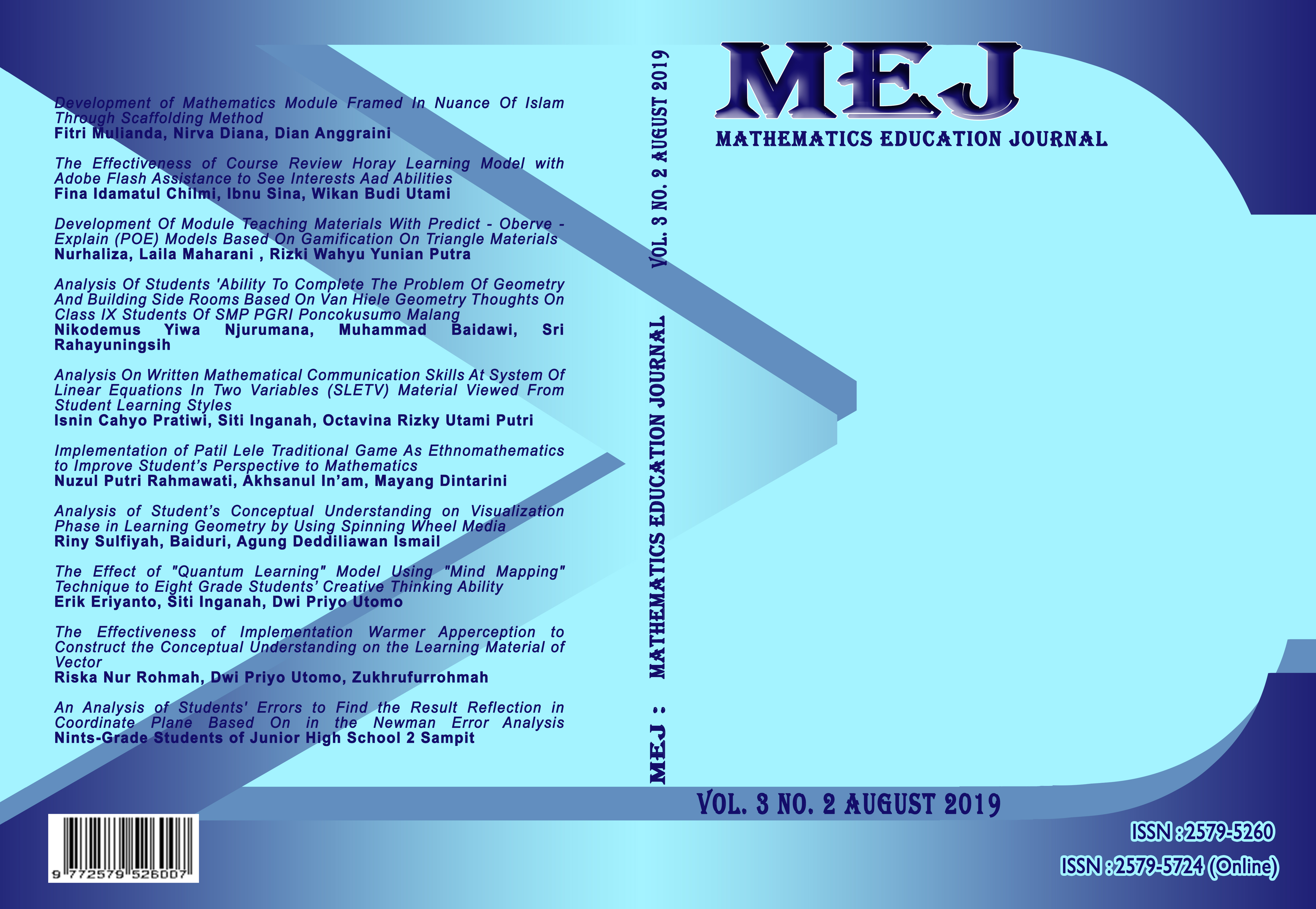Analysis of Student’s Conceptual Understanding on Visualization Phase in Learning Geometry by Using Spinning Wheel Media
DOI:
https://doi.org/10.22219/mej.v3i2.11071Keywords:
Conceptual Understanding, Van Hiele learning theory, spinning wheel mediaAbstract
This research aimed to describe the result of using the spinning wheel with steps based on Van Hiele theory, and to know student’s conceptual understanding in visualization phase through spinning wheel media and to describe the effectiveness of spinning wheel in improving student level of thinking from visualization phase to analysis phase. This research was descriptive research on experimental teaching which the research subject was seventh grade students at junior high school 4 Pamekasan consisted of 26 visualization phase students. The data collection techniques used in this research were observation, test, and interview. The resulting research showed that the learning process by using Van Hiele learning theory and spinning wheel media could attract student’s interest in the learning process, so students had the good conceptual understanding. Besides, the result showed the student’s understanding level at SMP 4 Pamekasan, it divided into two categories which were very good; and good. In the very good category, the average score was 89,5%. Then, a student’s conceptual understanding in the good category has 70,99% as the average score. It also stated that the spinning wheel that had been used was effective. It stated as effective because the spinning wheel media could improve from student’s visualization thinking to student’s analytical thinking level.Downloads
References
Al-ebous, T. (2016). Effect of the Van Hiele Model in Geometric Concepts Acquisition : The Attitudes towards Geometry and Learning Transfer Effect of the First Three Grades Students in Jordan, 9(4), 87–98.
Alex, J. K., & Mammen, J. K. (2015), Lessons Learnt from Employing van Hiele Theory Based Instruction in Senior Secondary School Geometry Classrooms. Eurasia Journal of Mathematics, Science & Technology Education, 2016, 12(8), 2223-2236 doi: 10.12973/eurasia.2016.1228a
Alqahtani, M.M. & Powell, A.B. (2016). Instrumental Appropriation of a Collaborative,Dynamic-Geometry Environment and Geometrical Understanding. InternationalJournal of Education in Mathematics, Science and Technology, 4(2), 72-83
Arikunto, suharsimi. (2013). Prosedur Penelitian Suatu Pendekatan Praktik. Jakarta: PT. Rineka Cipta
Armah, R.B., Cofie, P.O., & Okpoti, C.A. (2018). Investigating the effect of van Hiele Phasebased instruction on pre-service teachers’ geometric thinking. International Journal of Research in Education and Science (IJRES), 4(1), 314-330. DOI:10.21890/ijres.383201
Asrul, Karim. (2011). Penerapan Metode Penemuan terbimbing dalam Pembelajaran Matematika untuk meningkatkan Pemahaman Konsep dan Kemampuan Berfikir Siswa Sekolah Dasar. Jurnal Pendidikan Universitas Negeri Surabaya, Vol.2 No.1, Hal 20-39
Gravemeijer, K & Cobb, P. (2006). Design Research From A Learning Design Perspective. EducationalDesign Research.
Gravemeijer, K & Cobb, P. (2008). Experimenting to Support and Understand Learning Processes. Handbook of Design Research Methods in Education.
Halim, Abdulllah. (2015). The Effects of Van Hiele's Phases of Learning Geometry on Student’s Degree of Acquisition of Van Hiele Levels. International Journal Procedia - Social and Behavioral Sciences Volume 102, Pages 251-266
Ketut, Sutama. (2014). Pengembangan Perangkat Pembelajaran Geometri Berdasarkan Teori Van Hiele Berbantuan Wingeom Dalam Upaya Meningkatkan Aktivitas Dan Hasil Belajar Siswa. e-Journal Program Pascasarjana Universitas Pendidikan Ganesha Program Studi Matematika, Vol.6 No.2, Hal 11-21
Mariani, Andi. (2016). The Effect Of Van Hiele Learning Model Toward Geometric Reasoning Ability Based On Self-Efficacy Of Senior High School Students. Internation Journal of Mathematics Education, Vol 1 No 2
Safrina, Khusnul. (2014). Peningkatan Kemampuan Pemecahan Masalah Geometri Melalui Pembellajaran Kooperatif Berbasis Teori Van Hiele. Jurnal Didaktik Matematika, Vol.5 No.1, Hal 57-69
Salim, K. &Tiawa D.H. (2015). Implementation of Structured Inquiry Based Model Learning Toward Student’s Understanding of Geometry. International Journal of Research in Education and Science (IJRES), 1(1), 75-83.
Susanti, wiwi. (2011). Efektivitas model pembelajaran Van Hiele dengan alat peraga untuk meningkatkan hasil belajar siswa pada materi pokok bangun ruang sisi datar. Jurnal Pendidikan Matematika IAIN, Vol.1 No.4, Hal 24-41
Susilana, rudi. (2009).”MEDIA PEMBELAJARAN”. Bandung: CV Wacana prima
Usiskin, Z. (1982). Van Hiele Levels and Achievement in Secondary School Geometry. (Final report of the Cognitive Development and Achievement in Secondary School Geometry Project.) Chicago: University of Chicago. (ERIC Document Reproduction Service No. ED220288)
Yadil, Nur. (2009). Penerapan Model Pembelajaran van hiele untuk meningkatkan pemahaman siswa SMP karunadipa palu terhadap konsep bangun-bangun segiempat. Journal Matematika FMIPA UNY, Vol.1 No.4, Hal 19-27
Yeni, Ety. M. (2011). Pemanfaatan benda-benda manipulatif untuk meningkatkan pemahaman konsep geometri dengan kemampuan tilikan ruang siswa kelas V sekolah dasar. Jurnal Pendidikan Matematika Provinsi Aceh, Vol.2 No.4, Hal 26-43
Downloads
Published
Issue
Section
License
Authors who publish with MEJ (Mathematics Education Journal) agree to the following terms:
For all articles published in MEJ, copyright is retained by the authors. Authors give permission to the publisher to announce the work with conditions. When the manuscript is accepted for publication, the authors agree to automatic transfer of the publishing right to the publisher.
Authors retain copyright and grant the journal right of first publication with the work simultaneously licensed under a Creative Commons Attribution-ShareAlike 4.0 International License that allows others to share the work with an acknowledgment of the work's authorship and initial publication in this journal.
Authors are able to enter into separate, additional contractual arrangements for the non-exclusive distribution of the journal's published version of the work (e.g., post it to an institutional repository or publish it in a book), with an acknowledgment of its initial publication in this journal.
Authors are permitted and encouraged to post their work online (e.g., in institutional repositories or on their website) prior to and during the submission process, as it can lead to productive exchanges, as well as earlier and greater citation of published work (See The Effect of Open Access).

This work is licensed under a Creative Commons Attribution-ShareAlike 4.0 International License.










